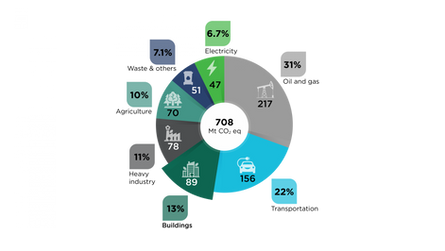Climate-conscious Canadians who are looking to reduce their carbon footprint should look no further than installing a Heat Pump. This one action will help them save money, live healthier and become more comfortable in their homes. It is a no-brainer.
What is a Heat Pump?
In the winter, the pump takes warm air from the outside and moves it inside the house. It might sound crazy but as long as the outdoor air temperature is above -273°C (absolute zero), there is heat in it. Current heat pump technology is able to heat homes leveraging the ‘warmth’ in the air even when it is -25°C outside.
In the summer, a heat pump takes the warm air inside of the house and shifts it outside. It is this ‘absence’ of heat that cools the house. Note: most traditional air conditioners work in a very similar way to the ‘cooling’ function of Heat Pumps.
Is Heating My Home Really That Bad for the Environment?
Yes.
13% of Canada’s GHG emissions (89 million tonnes of CO2e) are from heating & cooling buildings. Heat Pumps are so critical to Canada’s climate strategy, that in order to reach Net-Zero Emissions by 2050, the country must completely phase out the sale and installation of stand-alone fossil fuel heating systems by 2030.

For an individual home, the carbon impact of heating & cooling varies significantly, based on the size of home, climate conditions and efficiency of their current systems. But for the average Canadian home, installing a Heat Pump could reduce emissions by 6-10 tonnes of CO2 emitted / year.
If every home in Canada switched to a Heat Pump, it would reduce emissions by 26.3 megatonnes (4% of Canada’s total emissions). And this would increase even further if Heat Pumps were implemented in commercial and industrial buildings as well.
Let’s put this into context.

An economy-class return flight from London to New York: Emits an estimated 523 kgs of CO2 per passenger. This means that switching to a Heat Pump will save the equivalent of 12 cross-Atlantic flights per year for its lifetime.
What about when the electricity used to power the Heat Pump is generated using fossil fuels?
Heat Pumps benefit from one thing that traditional fossil-fuel based heating systems (think: gas furnace or boilers) do not: efficiency. Compared to the average heating system, at an above zero temperature, many Heat Pumps have a 3-4X Coefficient of Performance (COP), meaning that they are able to heat to the same temperature using just 1/4 the amount of energy. So even if 100% of the electricity being consumed was doing so by electricity generated by fossil-fuels, the total energy consumption would be 1/4 what it would be from a fossil-fuel based system.
In any event, for the vast majority of Canadians, electricity is generated by clean energy sources such as hydro, nuclear and wind power.
What next?
Installing a Heat Pump is an easy action that homeowners can take to make a significant reduction on their personal carbon footprint.
Learn more about if a Heat Pump could be right for you:


